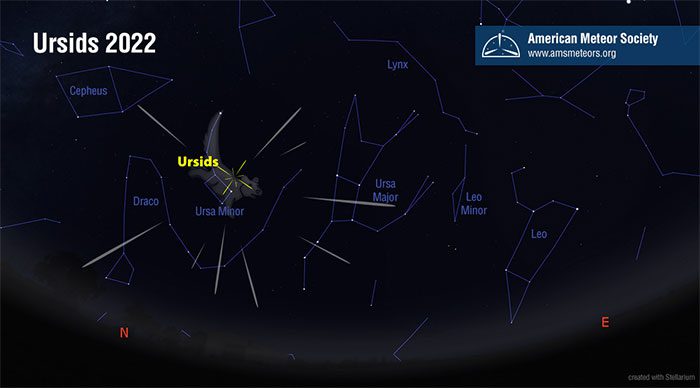With the dark of the new moon, Vietnamese people have a chance to clearly observe the last meteor shower of 2022 if the weather permits.
According to the positioning from Ho Chi Minh City on Time and Date, you can witness the most beautiful night of the Ursids meteor shower on the night of December 22 and the early morning of December 23, with about 10 meteors per hour.
Although this is just a small meteor shower compared to the dazzling Geminids in mid-December, it occurs at a favorable time for observation.

The Ursids meteor shower will radiate from the yellow point on the map, right in the constellation Ursa Minor, which is near the more easily visible constellations of Ursa Major and Draco – (Photo: AMERICAN METEOR SOCIETY)
By the morning of December 22, the Moon will be just a thin crescent under 3%, and by December 23, it will officially become a new moon – meaning the Earth, Moon, and Sun will be aligned with the Moon in the middle, making the dark side of the Earth completely unable to see it. Meteor showers typically have a much dimmer light than the moon, so they will be most beautiful on moonless nights.
The Ursids meteor shower appears to emanate from the Ursa Minor constellation (the Little Bear), hence the name closely resembles that of the constellation.
However, the true “mother” of the meteor shower is the comet 8P/Tuttle, a periodic comet with a 13.6-year orbit around the Sun. Nonetheless, it leaves behind a long trail of dust and debris that lasts long enough to create a meteor shower every time Earth passes through that trail in December each year.
The Ursids meteor shower is active from December 17 to December 24 each year; however, because it is not very “rich in particles”, observing on the exact peak night will make it easier for you to enjoy the spectacle.
How to observe the meteor shower is to choose a spacious area and temporarily keep your eyes away from lights and screens for 15-20 minutes to adjust to the darkness. Of course, hope for good weather as thick clouds can obscure the light of the meteors.


















































